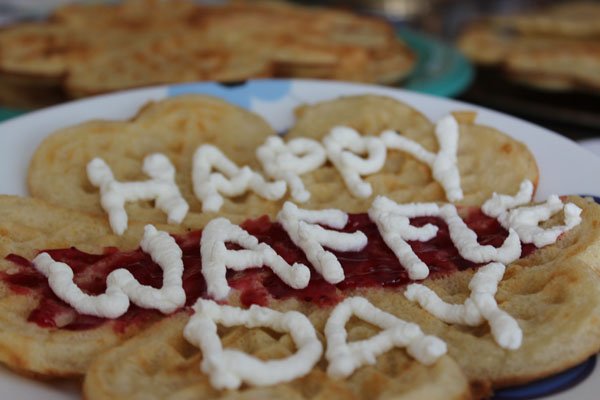Sweden celebrates one of its most cherished traditions – the Waffle Day (Våffeldagen) on 25th March, every year.
Swedes across the country and abroad enjoy crispy, golden waffles topped with jam, whipped cream, and fresh berries on this delightful day. Some even prefer savory options in waffles as well.
It is a celebration that combines tradition, love, culinary art, and shared communal joy.
Origins of Waffle Day
Waffle Day has an interesting origin story, rooted in a linguistic misunderstanding. This day coincides with the Christian Holiday Annunciation Day, known in Swedish as Vårfrudagen, which translated in English to “Our Lady’s Day.”
Over time, people started to mishear and pronounce Vårfrudagen as Våffeldagen, which means “Waffle Day.”
What started as a religious observance evolved into a national food holiday that Swedes eagerly anticipate each year.
Swedish Waffle Traditions
Unlike the Belgian waffles which are thicker, Swedish waffles are traditionally thinner and heart-shaped, made in a special waffle iron.
The most common way Swedes enjoy Waffles is with cloudberry jam, lingonberry jam, or fresh fruit like strawberries and raspberries. Swedes believe that their waffles are incomplete without complementary whipped cream topping.
In recent years, varieties have emerged, including savory waffles topped with cheese, salmon, or crème fraîche, reflecting modern culinary innovations.

On the annual Waffle Day, Swedish households, cafés, and restaurants prepare and serve waffles in large quantities. It is common for families to gather and enjoy homemade waffles, while eateries offer special deals and unique waffle-based dishes.
Many businesses and social organizations also take part in the festivities, making it a truly national celebration.
Sweden’s Waffle Influence Transcends Borders
Although Waffle Day is a distinctly Swedish tradition, its influence has reached far beyond the country.
This year, the Swedish Embassy in Pakistan also announced this celebration, engaging with food enthusiasts and promoting Swedish cultural traditions through social media.
Today, we are celebrating Waffle Day in Sweden—a delightful tradition that brings both warmth and sweetness to our hearts.
ENJOY crispy, golden waffles topped with jam, whipped cream, or fresh berries. It is all about the simple joys that make life sweeter!@SwedenAmbPK pic.twitter.com/1xYCXLfeU5— Sweden in Pakistan (@SwedeninPK) March 25, 2025
The rising popularity of Swedish cuisine globally has contributed to greater awareness and participation in Waffle Day beyond Sweden’s borders.
Waffle traditions are also found in other European countries including Belgium, Norway, and France – each having its own variation of waffles, with unique textures and toppings.
However, Swedish waffles, known for their light and crisp texture, hold a different supremacy among waffle lovers.
A Celebration of Swedish Culinary Heritage
Waffle Day in Sweden is not just about enjoying delicious waffles — it reflects Sweden’s love for simple yet meaningful traditions. The celebration highlights the country’s rich culinary heritage and the importance of food in connecting Swedes across the world.
Waffle Day can be enjoyed at home, with family or in a café with friends, as it provides a perfect chance to embrace Swedish culture and indulge in a delicious and sweet treat.
As Sweden marks this special occasion, people of other cultures also partake in the festivities by preparing or buying Swedish-style waffles.

Restaurants and cafés in Europe, North America, and Asia celebrate this day by offering free and complimentary waffle, showcasing the universal appeal of this everyday household eatable.
As Sweden gleefully observes Våffeldagen today, its a great day for waffle lovers to immerse themselves in this delightful occasion by experimenting with various recipes that bring unique flavors and toppings.
Whether crispy or fluffy, sweet or savory, waffles are a delightful symbol of warmth and culinary artistry.
Areeba Kanwal is a contributor at The Diplomatic Insight and has passion for International Relations and diplomacy.



